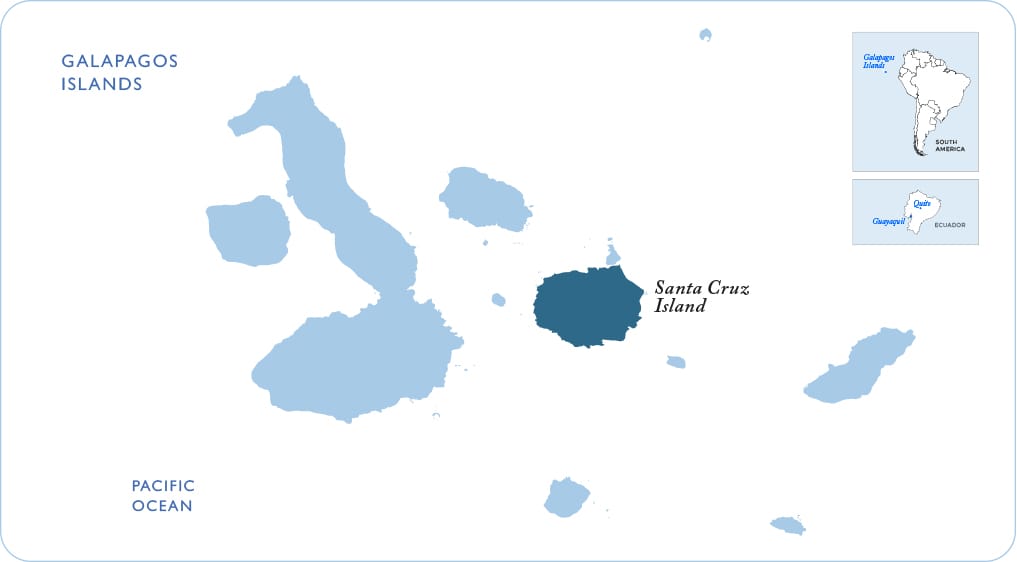- Home >
- Travel Guide >
- Galapagos Islands >
- About Galapagos >
- Santa Cruz Island>
About Santa Cruz Island in the Galapagos
Official Name: Santa Cruz Island
English Name: Indefatigable Island
Visitor Sites: Black Turtle Cove, Charles Darwin Research Station, Puerto Ayora, Dragon Hill, Santa Cruz Highlands
Area: 380 sq. miles (984 sq km)
Max altitude: 2834 feet (864 meters)
Approximate Age: 2 million years old
Animals Regularly Seen: Vermillion Flycatchers, Smooth-billed Ani, Giant Tortoises, Great Frigatebirds, Land Iguanas (in captivity), Great Blue Herons.
Animals Occasionally or Seasonally Seen: Vegetarian Finches, Woodpecker Finches.
Animals Rarely Seen: Dark-billed Cuckoo.
Outstanding characteristics: Giant tortoises (in wild and in captivity), land and marine iguanas, large variety of birds and varying vegetation.
Vegetation: It is the only island that has six different vegetation zones from the litoral and Arid Zones (where prickly pear cactus is found)to the fern and sedge, crossing the most humid zone with forests of scalesia and miconia.
Geology: Santa Cruz Island is composed of two parts: The younger and larger part is formed by many volcanic cones and basaltic lavas, while the older part is a narrow, 10 mile strip of land along the northeastern coast and consists of uplifted submarine lava flows and tuffs.
Santa Cruz Island is the second largest island in the Galapagos and something of a hub for the archipelago. Puerto Ayora, located in the southeast of this large, round volcanic island is the economic center of the Islands . It has the largest population among the four inhabited islands (approx. 18,000), which economically relies mostly on tourism—including refurbishing and resupplying Galapagos cruise yachts—along with fishing and boat-building.
Puerto Ayora is home to both the Galapagos National Park Service Headquarters and Charles Darwin Research Station, the center of the great restorative efforts taking place in the park, a UNESCO World Heritage site. Here we go ashore to visit the Giant Tortoise Breeding and Rearing Program run by the research station, which began by rescuing the remaining 14 tortoises on the island of Española in 1970. This program has restored the population of animals there to over 1,000 today. You will see many of these animals, with their sweet ET necks and faces; from hatchlings to juveniles to large, distinguished individuals like Lonesome George, the last of his particular race of tortoises. The local color of this port makes for an attractive stop-off, with restaurants, souvenir shops and internet cafés.
A highlight of any trip is a visit to Santa Cruz Highlands, where the dry coastal vegetation transitions to lush wet fields and forests overgrown with mosses and lichens. Our destination is the Tortoise Reserve, where we will have chances to track and view these friendly and ancient creatures in their natural settings. This extends to the adjacent pasturelands, where farmers make some profits by allowing visitors into their farms in exchange for payment. The best times to see tortoises here is during the cool or dry season from June through December. Another nearby attraction is the highland’s lava tubes. Some of tubes offer easy access by the means of wooden stairways that descend to the mouth of their arched cave entrances. From there one can make their way into the tubes underground along the cool, dimly lit naturally formed passages with their fascinating rock formations. The tubes make for a fairly easy and interesting hike. You should bring along non-slip footwear and some hikers prefer to use a flashlight.
Black Turtle Cove, located on the northern shore of Santa Cruz Island, is a living illustration of how mangroves alter the marine environment to create a rich and unique habitat. Four species of mangrove crowd from the shore out into the lagoon, which stretches almost a mile inland. As we drift though the quite waters in our dinghy, we are likely to see spotted eagle rays and cow nosed or golden rays, which swim in a diamond formation. White-tipped reef sharks can be seen beneath the boat and Pacific green sea turtles come to the surface for air and to mate. Sea birds, including pelicans, herons and egrets, all feed in the cove. This cove has been declared as a “Turtle Sanctuary”.
Las Bachas is a sandy white-coral beach that is a major egg-laying site for sea turtles. The name Bachas refers to the remains of landing craft left here at the end of WWII. Apparently, the locals couldn’t correctly pronounce what the US military called “the beach of the barges”. Instead the local fishermen and others started referring to the beach as “Las Barchas” and later that name devolved into “Las Bachas”. Ashore marine iguanas mingle with flamingos and other wading birds in another of the many super saline lagoons found in the Galápagos.
Another visitor’s site, Dragon Hill (Cerro Dragon)--located on the far western extreme of the island--makes and easy dry landing on a cement jetty. The path leads to a white sandy beach and then a rocky and dusty trail. Here the visitor will be rewarded by the presence of wading birds in another hyper-saline lagoon, and once inland, a nesting group of land iguanas. Less than a mile apart, a breathtaking dinghy ride will give the visitor an opportunity to see turtles and typically large numbers of sea birds as well as shark s in a mangrove environment.

